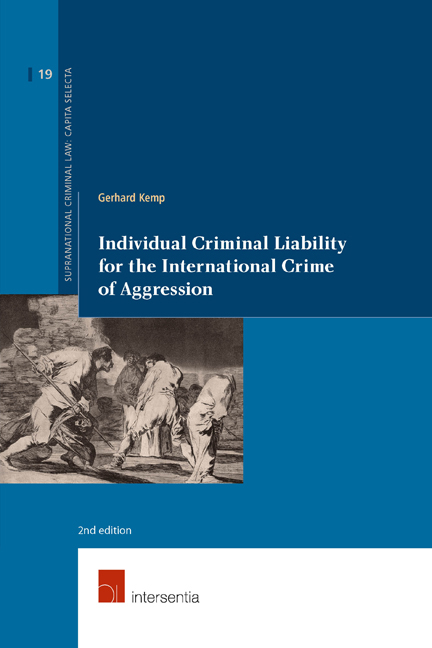Book contents
- Frontmatter
- Foreword to the Second Edition
- Foreword to the First Edition
- Preface
- Contents
- List of Abbreviations
- PART I INTRODUCTION AND FRAMEWORK OF ANALYSIS
- PART II COLLECTIVE SECURITY AND THE JUS CONTRA BELLUM
- Chapter I Aggression in the Context of Collective Security
- Chapter II From Jus Ad Bellum to Jus Contra Bellum: The Prohibition of the Use of Force in Normative and Institutional Perspective
- PART III THE CRIMINALISATION OF AGGRESSION
- PART IV THE INTERNATIONAL CRIMINAL COURT AND THE CRIME OF AGGRESSION
- PART V NATIONAL AND REGIONAL CRIMINALISATION AND PROSECUTION OF THE CRIME OF AGGRESSION
- PART VI ANNEXES
Chapter I - Aggression in the Context of Collective Security
from PART II - COLLECTIVE SECURITY AND THE JUS CONTRA BELLUM
Published online by Cambridge University Press: 12 December 2017
- Frontmatter
- Foreword to the Second Edition
- Foreword to the First Edition
- Preface
- Contents
- List of Abbreviations
- PART I INTRODUCTION AND FRAMEWORK OF ANALYSIS
- PART II COLLECTIVE SECURITY AND THE JUS CONTRA BELLUM
- Chapter I Aggression in the Context of Collective Security
- Chapter II From Jus Ad Bellum to Jus Contra Bellum: The Prohibition of the Use of Force in Normative and Institutional Perspective
- PART III THE CRIMINALISATION OF AGGRESSION
- PART IV THE INTERNATIONAL CRIMINAL COURT AND THE CRIME OF AGGRESSION
- PART V NATIONAL AND REGIONAL CRIMINALISATION AND PROSECUTION OF THE CRIME OF AGGRESSION
- PART VI ANNEXES
Summary
‘World history is largely a history of wars. All have been fought in a world without governance – where national “defence”, regional military alliances, balance of power and hegemonic imperialism have been the prevailing regimes. There is a manifest need for a system under universal auspices for maintaining global peace and security.’
COLLECTIVE SECURITY AS A MEANS TO PROMOTE AND SUSTAIN NTERNATIONAL PEACE AND SECURITY
The prohibition of aggression under international (criminal) law must be considered against the background of the collective security system. This system is primarily concerned with the maintenance of international peace and security. The criminalisation of aggression is analysed in terms of the international peace and security regime which developed during the twentieth century in the wake of two devastating world wars. While the focus of this book is the question of individual criminal liability as a response to (and possible deterrent for) international aggression, this must be seen contextually. Indeed, it will be shown that the criminal justice response to international aggression is ultimately not only intertwined with, but also to a considerable degree dependent upon, the key institutions of the system of collective security.
At present, the primary embodiment of the international collective security regime is the United Nations (UN). The UN Charter (1945) provides for three pillars of the system of collective security:
(a) pacific behaviour by states: Article 2(3) of the Charter provides that member states ‘shall settle their international disputes by peaceful means’. Furthermore, Article 2(4) provides that states ‘shall refrain in their international relations from the threat or use of force against the territorial integrity or political independence of any state’;
(b) collective responses and mechanisms aimed at the settling of disputes (notably in terms of Chapter VI of the Charter), and Chapter VII powers and mechanisms to deal with threats to or breaches of the peace and with aggression;
(c) international co-operation to deal with socio-economic development, decolonisation, and the advancement of human rights, as means to prevent international conflict.
- Type
- Chapter
- Information
- Publisher: IntersentiaPrint publication year: 2015

